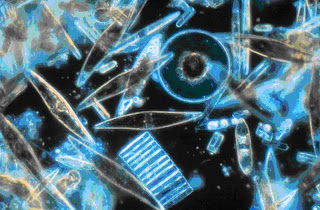 Diatom Genes and Nanomaterials
Diatom Genes and Nanomaterials
Nano-based technology is reliant on new methods of creating nanoscale materials inexpensively and on a massive scale; current methods are slow and expensive. The genes of diatoms, a major group of eukaryotic algae, are being closely examined and manipulated by scientists interested in solving the problem of creating viable nanomaterial. Diatoms encase themselves in a unique cell wall made out of silica through a process called biomineralization, which is the process of a single cell metamorphosing into inorganic material. There are thousands of diatom species, all with different shaped silica cell walls. Therefore, Diatoms can create complex inorganic structures with seemingly infinite variability, which is why scientists are so interested to utilize this ability to create nanomaterial.
Complete genome identification has already been undertaken for several species of diatoms. This research has located 1028 genes that are only found in diatoms and have no similarities in comparison to any other organisms’ genes. It is suggested that these genes have the encoding components responsible for its biomineralization ability. Scientists are currently attempting to manipulate the genes of the Diatom by implanting additional chemical materials into the DNA of the organisms. They have successfully introduced Au-labeled complementary ssDNA into the DNA of the diatoms, which resulted in the diatoms silica developing with a dense layer of gold particles. These results are encouraging and it is hoped that further research will eventually enable complete tailoring of diatom silica structures for nanotechnological purposes.
Article -
Kroger, N, Poulsen, N. (2008). Diatoms—From Cell Wall Biogenesis to Nanotechnology. Annual Review of Genetics, 42, 83-107.